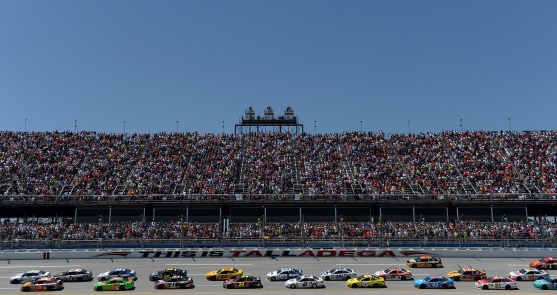So far this season, group qualifying has captured the attention of NASCAR fans. Television ratings are up during qualifying from a year ago and fans in general seem to like the new format. For most weekends qualifying has been really entertaining and fun to watch.
The exception to that would be qualifying at restrictor plate tracks in the 2014 season. Group qualifying was crazy at both Talladega in April and Daytona in July. The teams employed numerous gimmicks and several different strategies played out during the sessions that caused various issues. After Daytona in July, NASCAR made some changes and as teams prepare for this weekend’s Geico 500 at Talladega Superspeedway, there will be a new format for qualifying.
Robin Pemberton, NASCAR senior vice president of competition and racing development, explained the reason for the new format, saying, “This revision in national series qualifying at Talladega should be more exciting for our fans. It will feature a more accelerated pace, provide greater opportunity for team strategy to come into play and it should more closely resemble actual racing conditions.”
Qualifying for the Geico 500 will consist of three rounds. In the first round the field will be split into two groups and each group will have five minutes apiece to qualify. That means the 46 entries for Sunday’s race will be broken up into two 23 car packs during qualifying. The 24 drivers that post the fastest single lap speed from either of the two first round groups will advance to the second round. The remaining drivers’ starting positions will be based on their best speed as posted in the first round of qualifying, in descending order.
After a 10 minute break, the second round will begin and all times will be reset. The drivers will have five minutes to qualify and the 12 with the fastest single lap speed will advance to the third and final round. The remaining drivers will occupy starting positions 13-24, based on their best speed as posted in the second round of qualifying, in descending order.
After a five minute break, the final round will begin and all times will be reset. The fastest single lap speed will then determine positions 1-12, in descending order.
This type of qualifying at Talladega, particularly in round one with 23 cars on the track at one time, is where NASCAR is flirting with disaster.
Part of the reason why NASCAR made changes to the qualifying format was due to safety. Several drivers were making desperation moves to prevent other drivers from having great laps. Those moves will continue, especially during group two qualifying of round one, as drivers will have a better idea as to who will make the race and who won’t. I predict a lot of blocking and craziness will go on during the second group of first round.
With that being said is, it worth it? Is having a group qualifying session at the restrictor plate tracks worth tearing up a lot of racecars, just because NASCAR fans want an exciting format? Many team owners will have to face a financial burden just because fans want to be entertained. NASCAR Sprint Cup Series racecars cost more than they ever have and a wreck puts that financial burden on the owners, not NASCAR. Not only that but so much of Saturday’s qualifying session will be out of the teams and drivers’ control.
It’s hard to control how fast you go in the draft and with only five minutes to lay down a fast time, teams will get desperate especially in the second group of round one of qualifying. Teams that are not in the race could make last second efforts to either cut off a driver or cause a huge wreck while trying to get a fast time in qualifying. Some teams may not have a backup and may be forced to go home due to the wreck.
I have no problem trying to create excitement in qualifying for the plate tracks. Qualifying for these races has always been boring and never caused people to be on the edge of their seats. However, let’s not hurt the teams by doing it. Teams should have some control over their speeds in qualifying and control over whether or not their cars will get torn up in the process.







